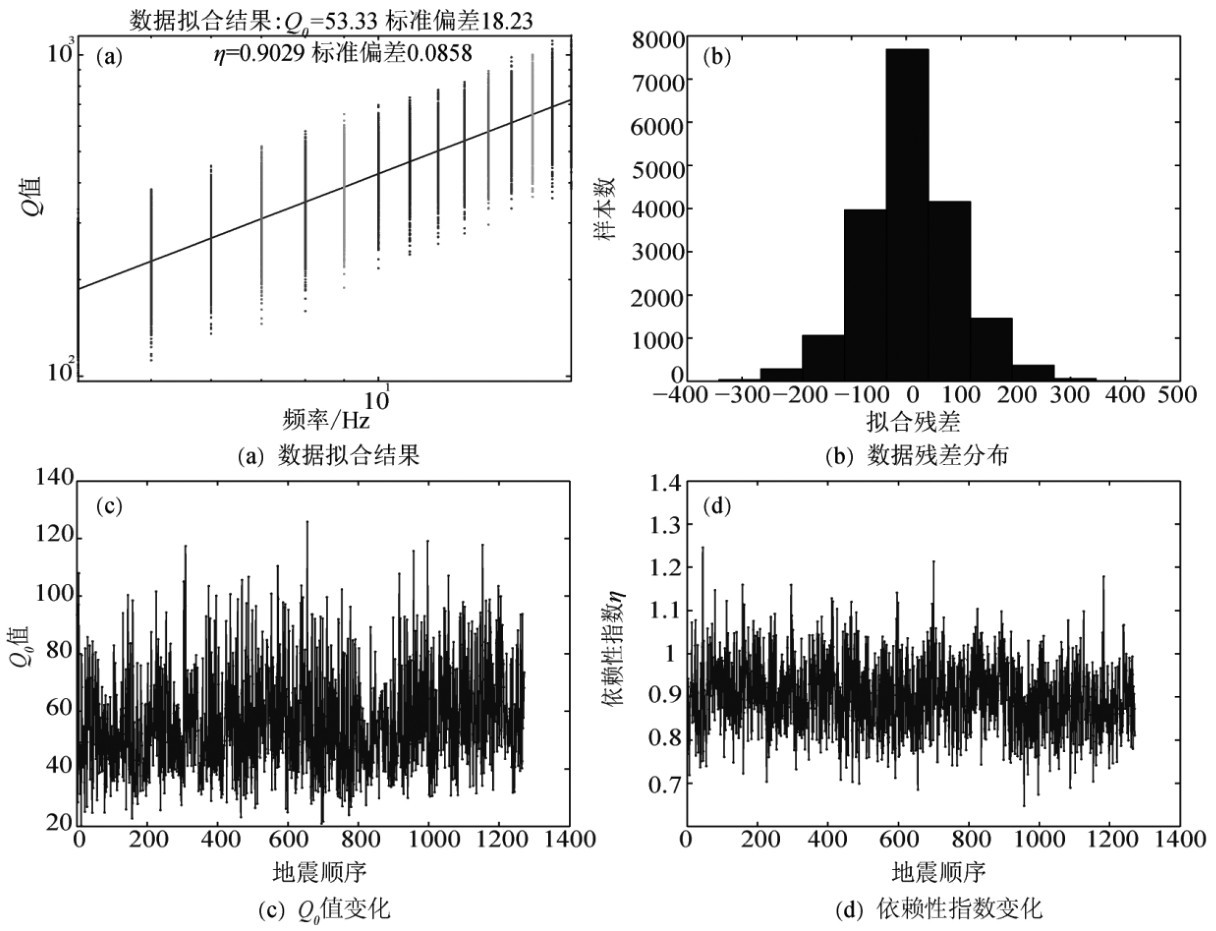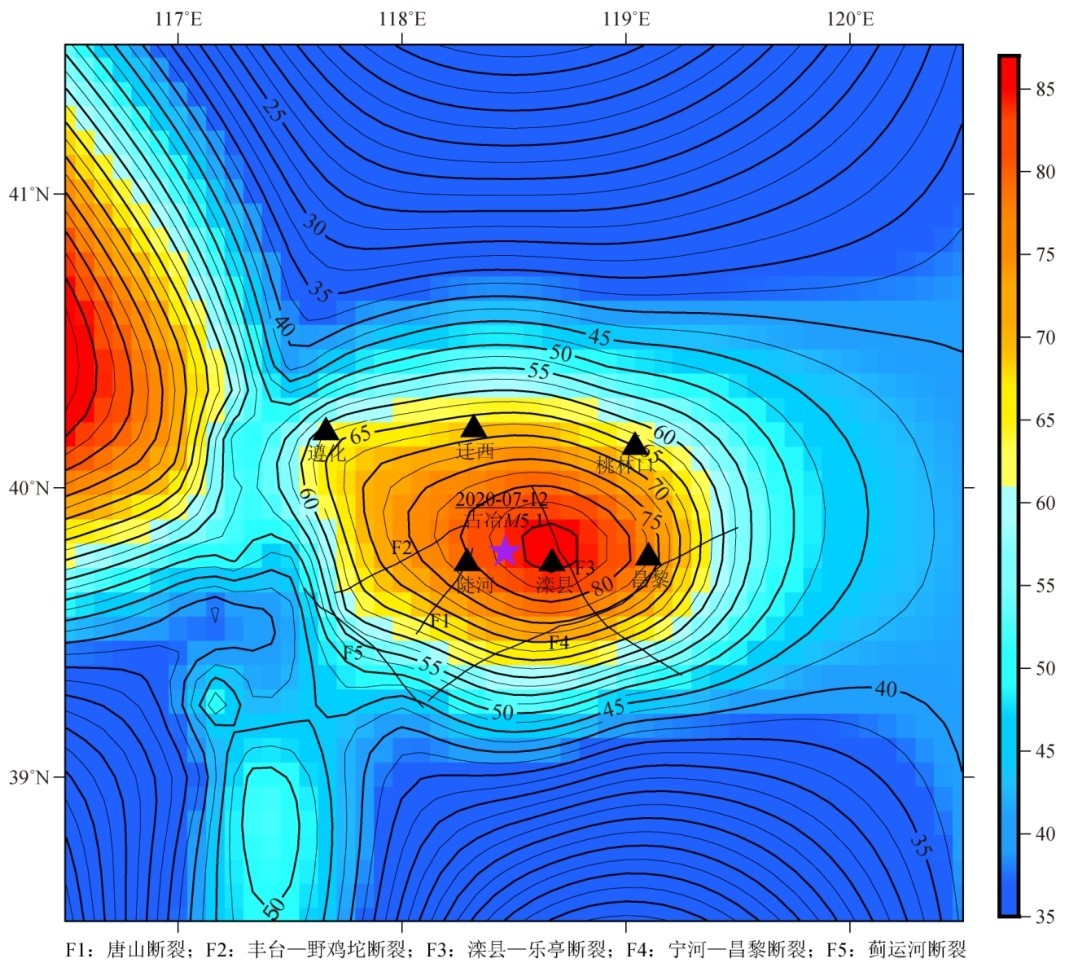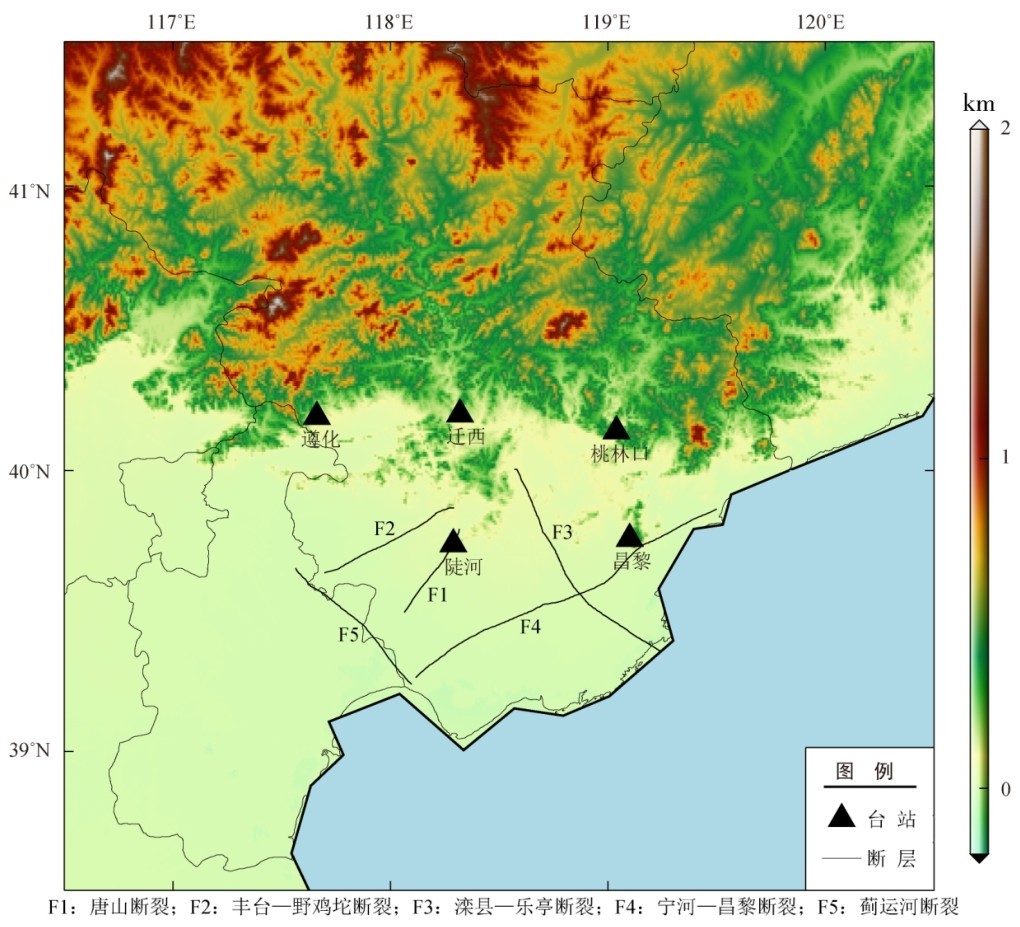利用Sato模型进行多台多地震联合计算和拟合,得到唐山地区平均尾波Q值与频率f之间的关系为Q(f)=(53.33±18.23)f0.9029±0.0858(图3)。结果显示,数据拟合度较高,拟合残差呈正态分布,1Hz频率对应的Q0值及频率依赖性指数η无明显趋势变化。尾波Q值主要反映以震源和记录台站为两个焦点的椭球范围内的品质因子特性[10]。用椭球体公式:
计算尾波平均采样深度约为70 km,而唐山地区地壳的平均厚度约为38 km,因此本文结果主要反映的是该区地壳和上地幔顶部的介质品质因子特征。
对比国内不同地区已有的Q值与频率关系的研究结果(表2),李松林等[17]、马云生等[8]、刘芳等[18]、翟浩等[19]选取与本文相近的流逝时间,分别对滦县、北京及邻区、内蒙古中西部、内蒙古东北部地区的尾波Q值进行了研究,计算得到的Q值均高于本研究区的相应值,而Q值对频率f的依赖性指数η低于本研究区的相应值。张小涛等[20]、吕坚等[21]、王曰风等[22]、阿衣仙姑·买买提等[23]选取比本文更短的流逝时间,分别研究得到邯郸—邢台、九江—瑞昌、张北、新疆阿克陶地区的Q值均高于本研究区的相应值,而Q值对频率f的依赖性指数η高于本研究区的相应值。这些结果差异可能是由于唐山地区中强地震频繁,地下岩石介质破碎程度较高,岩石圈的非均匀性较强,地震波传播过程中损耗的能量更多,造成该区尾波Q值相对较低。
图3 Q值与频率的关系Fig.3 Relationship between Q value and frequency
表2 Q值与频率关系相关研究结果比较Table 2 Comparison of research results related to the relationship between Qvalue and frequency
唐山地区尾波Q值随时间的变化显示(图4),该区ML4.5以上地震多发生在Q值下降过程中,且Q值在震前呈现上升变化,而震后则呈现下降变化。分析认为,尾波Q值的变化与周围介质物理性质的变化相关。地震发生之前较长一段时间,受较强应力作用,地壳介质特别是韧性层破裂的增加使尾波Q值减小,随着岩石被挤压,荷载也随之增加,深部介质的不均匀性降低,然后Q值不断增大,岩石不断积累应变能,受力超过它所能承受的极限后发生地震,能量被瞬间释放,岩石圈变得更加破碎,岩石之间的裂隙增大,流体的渗入增加了地震波的损耗,进而导致Q值变小。唐山地区尾波Q值的这种变化特征在陈婷等[24]研究结果中也有所体现。
选取研究区不同方位的5个测震台站(陡河、昌黎、迁西、遵化、桃林口)的尾波Q值随时间的变化,来进一步探究唐山地区的尾波Q值与中强地震之间的关系(图5)。结果显示,5个台站的尾波Q值在ML4.5以上地震前后出现了明显的波动变化,主要表现为震前低值回升,震后迅速下降。特别是在2016年9月10日唐山ML4.6地震前后,5个台站的尾波Q值变化规律具有很好的一致性。对比分析发现,陡河台和昌黎台的映震效果要好于其他3个台站,而陡河台Q值变化最为显著。经过对台站环境调研发现,与其它台站相比,陡河台台基较好,地震仪放置于地下室,周围环境噪声干扰很小。此外,陡河台距地震震中较近,且与大部分震源位于同一构造区域,认为陡河台的尾波Q值变化曲线能较好的反映唐山地区地壳介质的衰减特征。
图4 唐山地区尾波Q值演化(a)及M-T图(b) Fig.4 The map of Q value evolution(a)and the M-T map(b)in Tangshan region
唐山及邻区尾波Q值空间分布(图6)与地质构造及地形分布(图7)显示,唐山地区的尾波Q值存在显著的横向不均匀性,不同地区的Q值差异明显,北部山区的Q值高于南部平原地区,东部地区的Q值明显高于西部地区,沿着北东向的唐山断裂从西南向东北Q值逐渐升高。这一差异可能与该区壳幔深部构造的横向非均匀性有关。1976年7月28日唐山M7.8地震之后,唐山断裂西南段的岩石介质较为破碎,应力积累不明显。而唐山断裂东北段的岩石介质破碎程度低,随着应力的不断积累,地下介质的非均匀性降低,地震波传播过程中损耗的能量减少,衰减随之减小,造成该区域Q值较高。
唐山地区尾波Q值的高值异常区,与该区地壳和上地幔顶部三维速度结构的高速异常分布基本吻合[25-26]。京津唐地区地壳速度结构层析成像结果表明,在南部平原地区呈现P波低速速度异常,而在隆起的北部山区显示为P波高速速度异常,陡河至滦县地区P波速度在地下10 km、 15 km、70 km和105 km深度处为高速异常区。岩石实验结果表明[27],随着岩石孔隙度的增加,地震波传播速度减小,地震波衰减增加的趋势非常明显。由于P波高速异常区岩石介质的孔隙度较低,地震波衰减有所减弱,因此该区域尾波Q值较高。
陡河台和滦县台附近的尾波Q值的高值异常可能与该区的应力变化有关。朱琳等[28]研究了1976年唐山强震群震后库仑应力演化及其与2021年7月12日古冶5.1级地震的关系,认为震后15~20年内古冶地震震源区库仑应力呈现缓慢的、近似线性的增加状态。近年来,古冶震源区应力不断增加,导致唐山断裂东北段和滦县-乐亭断裂北段附近中小地震活动有所增强,岩石介质的不均匀性逐渐降低,地震波传播过程中损耗的能量减少,衰减较慢,使得陡河台和滦县台附近的尾波Q值相对较高。
地震尾波源于地震波在地球内部大量非均匀体间的多次散射。地震台站所处的局部场地环境因素:如地质构造、岩石裂隙、地下流体等都会对地震波传播产生影响。本文得到的结果尚需积累大量的震例资料来验证,有待于进一步深入研究。
图5 陡河(a)、昌黎(b)、迁西(c)、遵化(d)、桃林口(e)在1 Hz频率下的Q值演化及M-T图(f) Fig.5 Q value evolution of Douhe(a),Changli(b),Qianxi(c),Zunhua(d),Taolinkou(e)at 1 Hz and M-T diagram(f)
图6 研究区尾波Q值空间分布Fig.6 The spatial distribution of coda wave Q values in the study area
图7 研究区地质构造及地形分布Fig.7 Geological structure and topography distribution in the study area
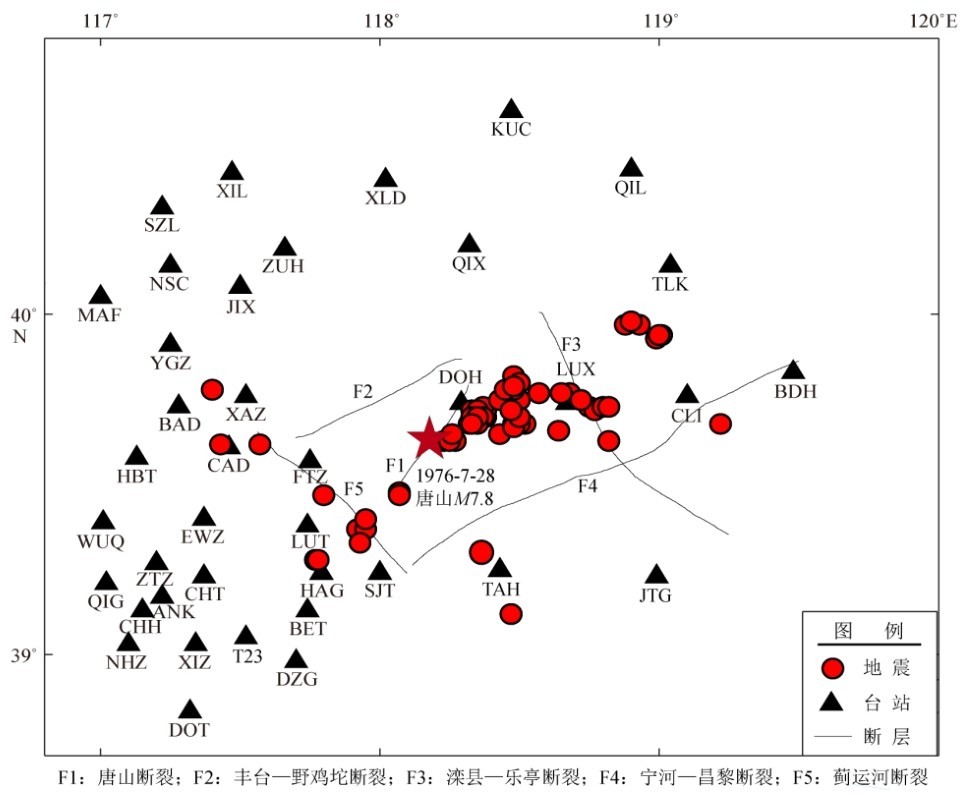
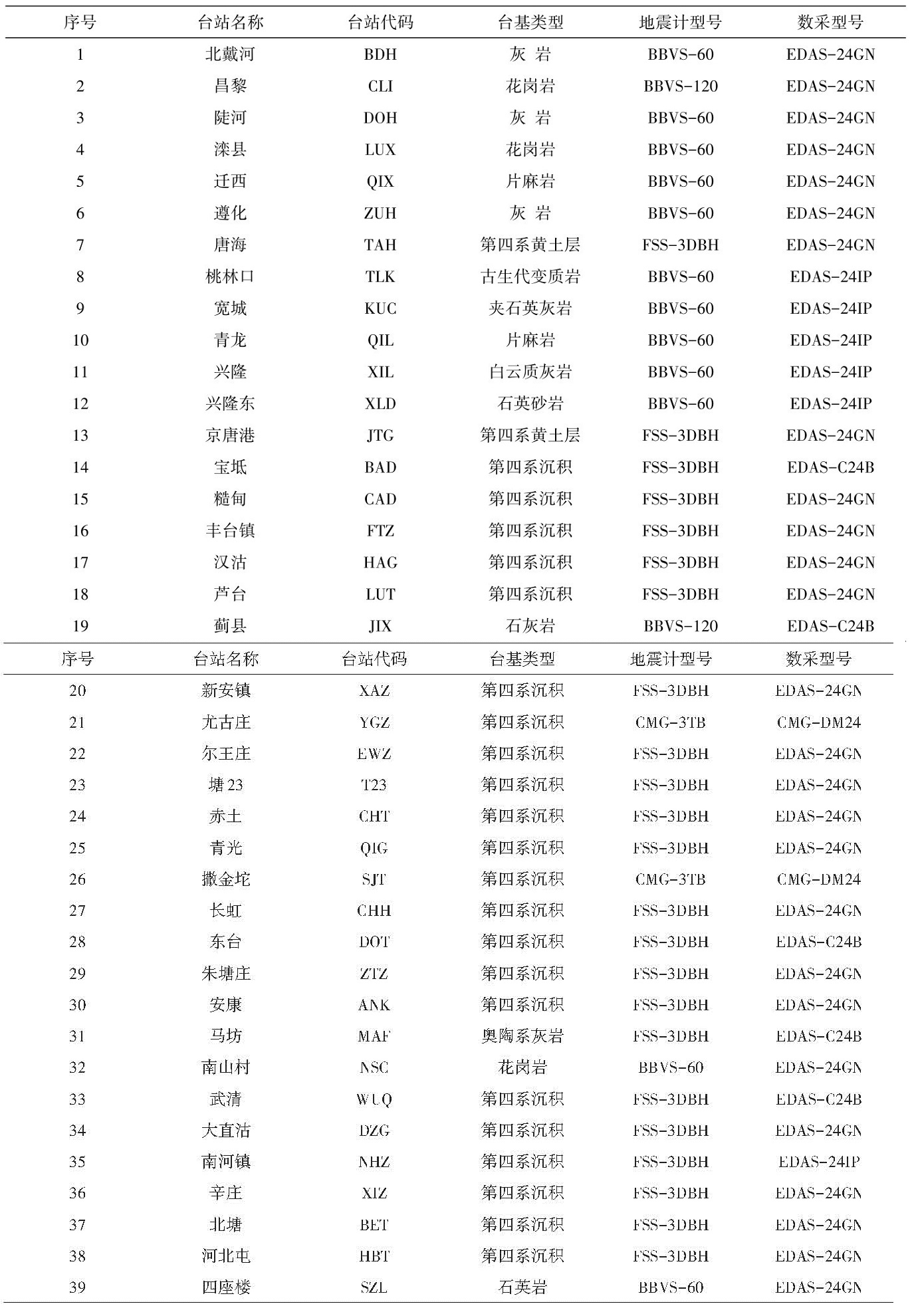
 带宽,使用六阶Butterworth滤波器对原始波形进行滤波处理;最后对滤波后的数据从S波到时开始取窗长2 s,步长0.5 s滑动计算求出不同时间点的平均振幅。不同的流逝时间反映了不同深度的Q值,计算时不同台站记录到不同地震所取的尾波流逝时间应保持一致,本文将尾波窗长固定为80 s。
带宽,使用六阶Butterworth滤波器对原始波形进行滤波处理;最后对滤波后的数据从S波到时开始取窗长2 s,步长0.5 s滑动计算求出不同时间点的平均振幅。不同的流逝时间反映了不同深度的Q值,计算时不同台站记录到不同地震所取的尾波流逝时间应保持一致,本文将尾波窗长固定为80 s。

